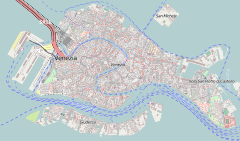| Church of San Salvador | |
|---|---|
 Face of San Salvador Face of San Salvador | |
| Religion | |
| Affiliation | Roman Catholic |
| Province | Venice |
| Location | |
| Location | Venice, Italy |
  | |
| Geographic coordinates | 45°26′12″N 12°20′11″E / 45.4366°N 12.3365°E / 45.4366; 12.3365 |
| Architecture | |
| Architect(s) | Giuseppe Sardi(facade) |
| Type | Church |
| Style | Baroque, Renaissance |
| Completed | 1663 (facade) |
The Chiesa di San Salvatore (of the Holy Savior) is a church in Venice, northern Italy. Known in Venetian as San Salvador, is located on the Campo San Salvador, along the Merceria, the main shopping street of Venice. The church was first consecrated in 1177 by Pope Alexander III shortly after his reconciliation with Emperor Frederick Barbarossa at nearby San Marco. The present church, however, was begun in around 1508 by Giorgio Spavento and continued after his death the following year by Tullio Lombardo, Vincenzo Scamozzi and possibly Jacopo Sansovino. They built a large hall church, formed from three Greek crosses placed end to end. Each has a dome with a lantern to let light into the cavernous interior. The facade was added in 1663 by Giuseppe Sardi.
Adjoining the church is the former monastery, now the offices of the telephone company, which still contain Sansovino's magnificent cloisters.
San Salvador is the parish church of a parish in the Vicariate of San Marco-Castello. Other churches in the parish are San Bartolomeo and San Zulian.
San Salvador is a small, but still-active religious, cultural and social centre.
Below the left column on the facade there is a cannonball embedded in the base of the column. It derived from a bombardment in 1849 by Austrian forces in the port of Marghera, of the independent republic which had been proclaimed by Daniele Manin.

Works of art
- Jacopo Sansovino (tomb of Francesco Venier on the south wall).
- Titian (Annunciation on the south wall and Transfiguration, the altarpiece of the high altar).
- Francesco Vecellio (paintings on organ doors; frescoes in tomb in floor in front of high altar).
- Alessandro Vittoria (altar on north wall, with statues of St. Roch and St. Sebastian).
- Giulio Angolo del Moro Savior in Monument of Andrea Dolfin.
-
 Francesco Venier's monument
Francesco Venier's monument
-
 Titian (Annunciation
Titian (Annunciation
-
 Organ
Organ
-
 Resurrection by Francesco Vecellio
Resurrection by Francesco Vecellio
-
 Transfiguration by Francesco Vecellio
Transfiguration by Francesco Vecellio
-
 St. Roch by Alessandro Vittoria
St. Roch by Alessandro Vittoria
-
 St. Sebastian by Alessandro Vittoria
St. Sebastian by Alessandro Vittoria
-
 Savior by Giulio del Moro
Savior by Giulio del Moro
Funerary monuments
- Caterina Cornaro (d.1510) (Queen of Cyprus).
- Andrea Dolfin
- Doge Gerolamo Priuli
- Doge Lorenzo Priuli
- Doge Francesco Venier (d.1556).
See also
External links
- web site Archived 2010-03-13 at the Wayback Machine


